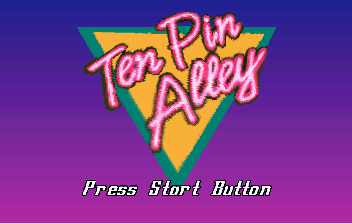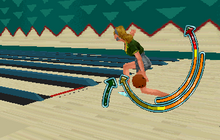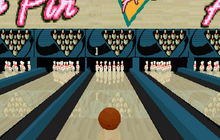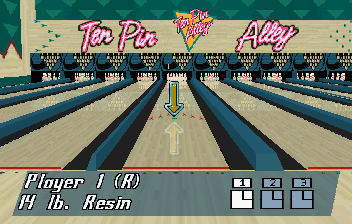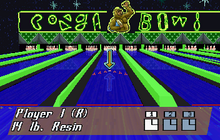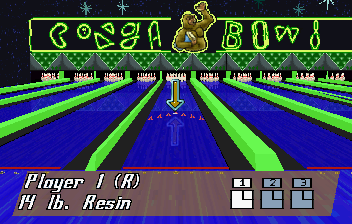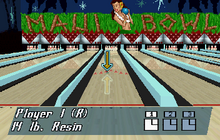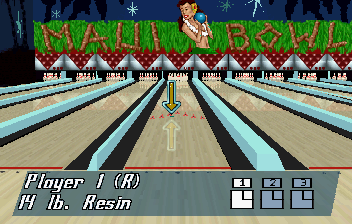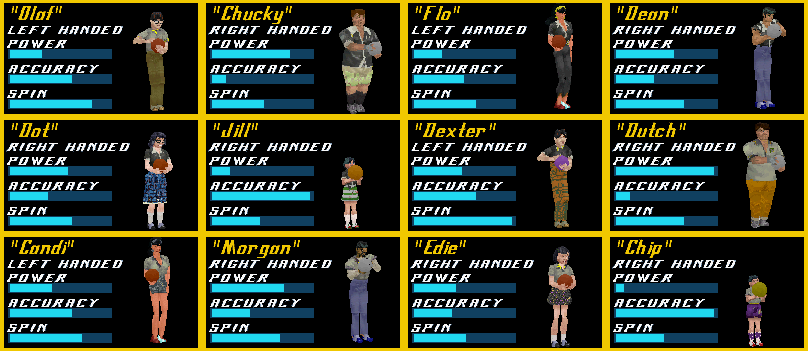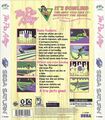Ten Pin Alley
From Sega Retro
| Ten Pin Alley | ||||||||||
|---|---|---|---|---|---|---|---|---|---|---|
| System(s): Sega Saturn | ||||||||||
| Publisher: ASC Games | ||||||||||
| Developer: Adrenalin Entertainment | ||||||||||
| Peripherals supported: 6Player, Saturn Backup Memory | ||||||||||
| Genre: Sports (bowling) | ||||||||||
| Number of players: 1-6 | ||||||||||
| ||||||||||
|
Ten Pin Alley is a ten pin bowling game released for the Sega Saturn exclusively in North America.
A PAL version was planned, set to be distributed by Electronic Arts[2], but it failed to materialise.
Contents
Gameplay
The game is a bowling game that supports up to six players (using the 6Player adapter). The goal is to roll a ball down a lane and try to knock over as many pins as possible. The player has two rolls per frame, and each game lasts for ten frames.
Players can create a bowler from twelve different characters, who are rated on power, accuracy, and spin. Bowlers can be customized with six outfit colors, four hair colors, and four skin tones. Players can choose between three different ball cover stocks (plastic, urethane, and resin, with plastic hooking the least and resin hooking the most) and a range of ball weights (from 8 to 16 pounds, in one-pound increments). There are three skill levels (Rookie, Journeyman, and Pin King or Pin Queen). The game keeps statistics for each player (such as their best score or percentage of strikes or spares) and saves them to the Saturn's internal memory or to a memory cartridge.
At the start of each frame, the bowler aims the ball with ![]() or
or ![]() . Selections are confirmed with
. Selections are confirmed with ![]() or
or ![]() . The player then moves the bowler into position with
. The player then moves the bowler into position with ![]() or
or ![]() .
.
Then three meters with arrows at the ends appear. The green meter on the left controls the amount of spin put on the ball. For right-handed bowlers, holding ![]() increases the spin and holding
increases the spin and holding ![]() decreases the spin; for left-handed bowlers, the directions are reversed. The two larger meters are controlled in a similar fashion to a golf game, using an accuracy-based pendulum system. The power meter at the top fills first, and the player stops it to determine the power of the roll. The small, light yellow segment of the meter shows the optimal power level, while letting the meter fill without stopping it causes the bowler to whiff the shot. The release meter fills next, which determines the point at which the bowler releases the ball. Again, the bright yellow segment shows the ideal release point, while letting the meter fill causes the bowler to fail to release the ball. The camera follows the ball down the lane until it hits the pins.
decreases the spin; for left-handed bowlers, the directions are reversed. The two larger meters are controlled in a similar fashion to a golf game, using an accuracy-based pendulum system. The power meter at the top fills first, and the player stops it to determine the power of the roll. The small, light yellow segment of the meter shows the optimal power level, while letting the meter fill without stopping it causes the bowler to whiff the shot. The release meter fills next, which determines the point at which the bowler releases the ball. Again, the bright yellow segment shows the ideal release point, while letting the meter fill causes the bowler to fail to release the ball. The camera follows the ball down the lane until it hits the pins.
At any point, players can pause the game with START and view the scoreboard or the player statistics or modify the bowler (including changing the ball). Failed shots are marked as fouls ("F") on the scorecard.
Bowling lanes are coated in a thin layer of oil to help the ball slide down smoothly. This lane dressing covers two-thirds of the lane, starting from the foul line, which causes the ball to hook slightly when the dressing ends. This effect is recreated for the game. The oil dries out over the course of the game, lessening its effect (though this can be disabled in the options).
Modes
The game has multiple modes. Any mode can have one to six players, which can be any combination of human and computer players, determined before starting the game.
- Open Play: A standard game of ten frames where the game keeps score. It can be played alone or with human or computer competitors.
- Practice: A practice mode where the game does not keep score. Players can customize the layout of the pins (by removing any pins) before every throw to practice difficult splits.
- Team Play: A standard game where the players are divided into teams of 1, 2, or 3 bowlers. Both teams must have the same number of players. Each team can pick from a selection of team logos.
- Tournament: A single-elimination tournament consisting of 64 players (with the results of the other players determined by the computer, without their frames being shown). Players earn "cash rewards" for their performance. There are three difficulty levels for tournaments (Beginner, Amateur, and Pro), with the lower difficulty levels having less challenging opponents and smaller cash prizes. Tournament progress is saved to the Saturn's internal memory or a memory cartridge.
There are two scoring options: Standard and No Tap. No Tap counts either 9 or 10 pins knocked down on the first roll as a strike, which is more forgiving for novice bowlers.
Alleys
Bowlers
| Olaf | |
|---|---|
| Chucky | |
| Flo | |
| Dean | |
| Dot | |
| Jill | |
| Dexter | |
| Dutch | |
| Condi | |
| Morgan | |
| Edie | |
| Chip | |
History
Legacy
A sequel, Ten Pin Alley 2, was released for the Game Boy Advance in 2004 and the Nintendo Wii in 2008.
Production credits
- Produced for ASC Games by: Ron Rivkin
- Original Concept: David Klein, Ron Rivkin
- Associate Producer: Paul Lindsay
- Artwork & Packaging: Todd Emmerson
- Manual: Jayson Bernstein, Jeff Castaneda, Jana Gabe, Kelly McAllen, Mark Alan Miller, Ron Rivkin
- Testers: Mick Devitt, Oswald Greene
- Special Thanks: Tim Barleycorn, Jayson Bernstein, Brent Disborow, Jason Gomez, Steve Grossman, David Klein, Bill Kosovitch, Mike Masone, Jill Price, Jay Smith, Dean Wittig, Sharon Wood
- Special thanks to: the International Bowling Museum and Hall of Fame®, Gerald W. Baltz, John Dalzell
- Executive Producer: Jay Smith
- Producer: Mark Alan Miller
- Game Design: Ofer Estline, Ian McIntosh, Mark Alan Miller, Alan O'Brien, David Ray, Alex Shatsky
- Physics Model: Mark Alan Miller, Jay Smith
- Saturn Programmer: Nathan Mates
- Additional Programming: Ofer Estline, J. David Ray, Alex Shatsky
- Lead Artist & Character Design: Ian McIntosh
- Lead Animation: Alan O'Brien
- Saturn Art Conversions and Additional Art: Matthew Dana Heller
- Model Builder: Ben Lazarro
- Backgrounds and Additional Art: Bernie Petterson
- Sound Design & Music: Peter Kerekes
- Animation Sound Effects: Greg Shaw
- Lounge "Jukebox" Music: Eric Speier
- Rock "Jukebox" Music: Killer Tracks
- Adrenalin Software Director: Anthony Farmer
- Adrenalin Art Director: Bonnie Hammer
- Bowling Advisors: Daniel Speranza, Larry Vezina
- Very Special Thanks: George deGolian, Randy Eubanks, Susan Monsell-O'Brien, Nicole Nelsen, Christine Peterson, Spencer Smith, Tim Watson
Magazine articles
- Main article: Ten Pin Alley/Magazine articles.
Physical scans
| Sega Retro Average | |||||||||||||||||||
|---|---|---|---|---|---|---|---|---|---|---|---|---|---|---|---|---|---|---|---|
|
| 80 | |
|---|---|
| Based on 3 reviews | |
Technical information
- Main article: Ten Pin Alley/Technical information.
References
- ↑ http://riehlspot.simplenet.com/vgame/new/saturn.html (Wayback Machine: 1999-02-21 17:22)
- ↑ http://www.ascgames.com/news/news.06.shtml (Wayback Machine: 1997-07-13 22:56)
- ↑ File:Tenpinalley sat us manual.pdf, page 15
- ↑ Consoles +, "Février 1997" (FR; 1997-0x-xx), page 126
- ↑ GamePro, "December 1997" (US; 1997-xx-xx), page 184
- ↑ Game Informer, "February 1998" (US; 1998-0x-xx), page 54
| Ten Pin Alley | |
|---|---|
|
Main page | Comparisons | Hidden content | Magazine articles | Reception | Technical information | |
